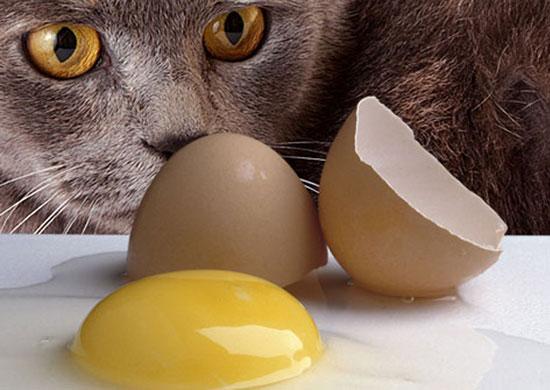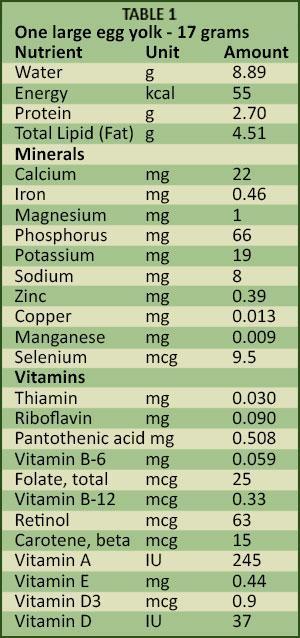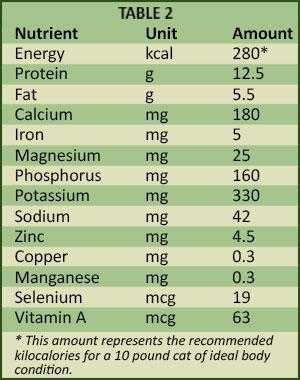This content is archived from the Feline Nutrition Foundation
Answers: Feed My Cat a Raw Egg Yolk?
- Updated: Saturday, June 01, 2019 05:28 PM
- Published: Saturday, February 12, 2011 05:00 PM
- Written by Elisa Katz, DVM
 All of the raw diet recipes for cats I see contain raw egg yolks. What do they contribute to a cat's nutrition? My cat loves to eat them. Is it all right to give her a whole raw yolk occasionally? Is there really a difference between regular, organic and free-range eggs?
All of the raw diet recipes for cats I see contain raw egg yolks. What do they contribute to a cat's nutrition? My cat loves to eat them. Is it all right to give her a whole raw yolk occasionally? Is there really a difference between regular, organic and free-range eggs?
Egg yolks contain many nutrients, as can be seen in Table 1.¹ They are an excellent source of protein. Just one provides 21 percent of a cat's recommended daily intake of this nutrient. They contain a total of 19 different amino acids, including the ten considered essential for the cat. As obligate carnivores, they cannot make them on their own. They must eat them in their food. These are: arginine, histidine, isoleucine, leucine, lysine, methionine, phenylalinine, threonine, tryptophan and valine. The one important essential amino acid that egg yolks do not contain is taurine.


Table 2 shows some of the recommended daily nutrient allowances for an average cat.² As you can see, egg yolks contain many of the vitamins and minerals required. One large yolk can contribute 12 percent of the daily requirement of calcium and 9 percent of iron. They are also a good source of some of the B vitamins. Abbreviations used in both tables are as follows: kcal = kilocalories, g = gram, mg = milligram, mcg = microgram, IU = international unit.
I see no problems with feeding your cat raw egg yolks from time to time. But try to avoid raw egg whites, as these contain a protein called avidin. It can bind to certain B vitamins and prevent their absorption.³
As for the answer to the third part of your question, there are differences between factory-farmed regular, organic and free-range eggs and chickens. The basic differences are in the lifestyle and diet of the hens. The factory-farmed birds are kept in very small cages and can barely move. This is how they spend their entire lives. They are fed diets that can consist of dead animal parts, including other chickens and livestock and pesticide-contaminated grains.⁴ Factory-farmed chickens may also receive hormones and antibiotics either directly or indirectly through their feed.
Organic can mean different things depending on which organization you ask, the USDA or the National Organic Standards Board. For the most part, the certified organic label indicates that the hens are fed an organically grown feed and given no hormones or antibiotics. They may still be confined.⁵ Free-range in countries other than the United States means that the chickens are pasture-raised and are able to participate in all of their natural behaviors. Hence, they have less stressful lives than caged hens or those let out for only short periods of time. According to the USDA however, free-range means merely, "Producers must demonstrate to the Agency that the poultry has been allowed access to the outside."⁶ This could mean confined to a cage 90 percent of the time with an open door, regardless of whether or not the animal actually goes outside.
Additional Reading
Salmonella: The Chicken or the Egg
Calcium Supplements in Homemade Cat Food
Nutritionally, there may or may not be differences other than the absence of pesticides, hormones and antibiotics in organic eggs. I would suspect that true free-range eggs would be higher in nutrients because the chickens in general lead healthier, less stressful lives, and therefore can produce better eggs.
Note: Feline Nutrition provides feline health and nutrition information as a public service. Diagnosis and treatment of specific conditions should always be in consultation with your own veterinarian. Feline Nutrition disclaims all warranties and liability related to the veterinary advice and information provided on this site.
Dr. Elisa Katz, DVM, is a graduate of Ohio State University and is the owner of Natural Pet Animal Hospital in Bourbonnais, Illinois. She practices holistic and integrative medicine focusing on proper diet and nutrition. Dr. Katz shares her home with four kitties and one dog.
1. USDA National Nutrient Database for Standard Reference, Release 28, September 2015.
2. "Your Cat's Nutritional Needs, A Science-Based Guide for Pet Owners," National Research Council of The National Academies, July 24, 2006.
3. Jane Higdon, PhD, "Biotin," Micronutrient Information Center, Linus Pauling Institute, Oregon State University, August 2008.
4. Sapkota, A.R., L.Y. Lefferts, S. McKenzie and P. Walker, "What Do We Feed to Food-Production Animals? A Review of Animal Feed Ingredients and Their Potential Impacts on Human Health," Environmental Health Perspectives 115, no. 5, 2007, 663-670.
5. "Scrambled Eggs: Separating Factory Farm Egg Production from Authentic Organic Agriculture," The Cornucopia Institute, 2010.
6. "Food Labeling," USDA Food Safety and Inspection Service, Fact Sheet, October 29, 2010.




